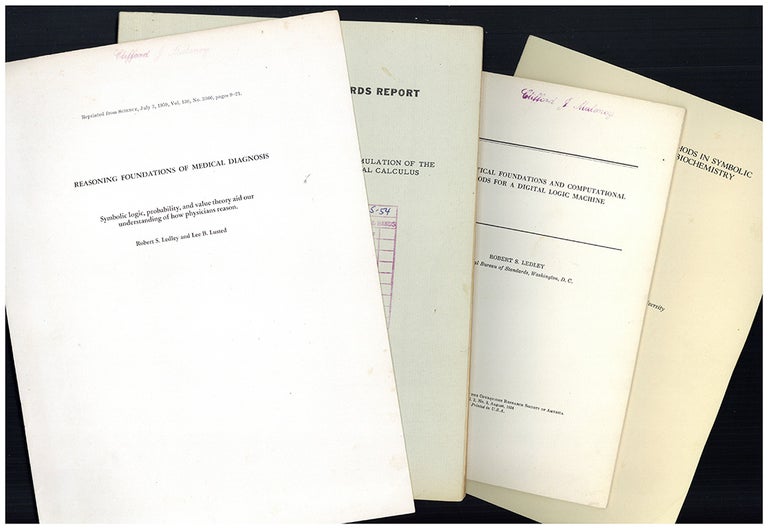
Reasoning foundations of medical diagnosis plus 3 other related papers
Beginning of Health Information Technology Systems
Ledley, Robert S. (1926-2012) and Lee B. Lusted (1922-94). (1) Reasoning foundations of medical diagnosis. Offprint from Science 130 (1959). 13pp. Text illustrations. 287 x 211 mm. Original printed wrappers, ownership stamp on front wrapper. (2) Ledley. National Bureau of Standards Report 3363. A digitalization, systematization and formulation of the theory and methods of the propositional calculus. Offset typescript. [2], v, 82pp. Text diagrams. Washington, DC: U.S. Department of Commerce, National Bureau of Standards, Feb. 1, 1954. 268 x 206 mm. Original printed wrappers, stamp on front wrapper dated “9-15-54” in manuscript. (3) Ledley. Mathematical foundations and computational methods for a digital logic machine. Offprint from Journal of the Operations Research Society of America 2 (1954). 249-274pp. Text diagrams. 230 x 152 mm. Original printed wrappers, ownership stamp on front wrapper. (4) Ledley. Digital computational methods in symbolic logic, with examples in biochemistry. Offprint from Proceedings of the National Academy of Science 41 (1955). 498-511pp. Text diagrams. 258 x 176 mm. Original printed wrappers. Together 4 items. Very minor spotting on some wrappers, but very good overall.
First Editions; Offprint Issues of nos. (1), (3) and (4). Ledley pioneered the use of electronic digital computers in biology and medicine. Trained as both a physicist and a dentist, Ledley joined the National Bureau of Standards in 1952, where he was introduced to electronic computing through his wife, one of the programmers on the Standards Eastern Automatic Computer (SEAC). Recognizing the enormous potential importance of computers to biomedical research, Ledley devoted the rest of his career to advancing the use of digital computing in biology and medicine. In 1960 he founded the National Biomedical Research Foundation (NBRF), which he headed until his retirement in 2010. His major accomplishments at the NRBF include the invention of the ACTA whole-body CT scanner (1973) and the establishment of the Protein Information Resource in the 1980s.
Ledley’s “Reasoning foundations of medical diagnosis,” written in collaboration with radiologist Lee Lusted, represents the beginning of the development of clinical decision support systems (CDSS)—interactive computer programs, or expert systems, designed to assist physicians and health care professionals with decision-making tasks.
"Areas covered included: symbolic logic, Bayes’ theorem (probability) and value theory. In the article, physicians were instructed how to create diagnostic databases using edge-notched cards to prepare for a time when they would have the opportunity to enter their data into electronic computers for analysis. Ledley and Lusted expressed hope that by harnessing computers, much of physicians’ work would become automated and that many human errors could therefore be avoided. Within medicine, Ledley and Lusted’s article has remained influential for decades, especially within the field of medical decision-making" (Wikipedia).
While at the National Bureau of Standards, Ledley devoted most of his time to solving military and intelligence problems using the techniques of operations research. Nos. (2) and (3) above (no. [3] is a revised version of no. [2]) discuss the use of Boolean algebra to simplify complex military decision-making processes. After leaving the NBS in 1954 Ledley joined the Operations Research Office at Johns Hopkins; one of his colleagues there was physicist George Gamow, who had become interested in molecular biology after Watson and Crick’s discovery in 1953 of the double helix structure of DNA. Gamow sponsored Ledley for membership in the elite RNA Tie Club and enlisted Ledley’s computing expertise in an attempt to crack the genetic code. Ledley’s results were published in no. (4) above:
"Ledley’s main work for the RNA Tie Club was an effort to generate a set of contingency tables for the purpose of writing a computer program that would determine the correspondence between any three-letter sequence (triplet) of nucleotide bases and any amino acid . . . Sponsored by Gamow, Ledley published his work in 1955 in the Proceedings of the National Academy of Sciences. Though Ledley had produced a combinatorial table that could theoretically be used to determine which three-letter sequence of DNA bases corresponded to which amino acid, the problem required several thousand years of computation time on the world’s fastest computers (circa 1955) to produce a solution" (Wikipedia).
The genetic code was eventually broken in the 1961 Nirenberg and Matthaei experiment, which did not use computers.
Book Id: 43185Price: $7,500.00
